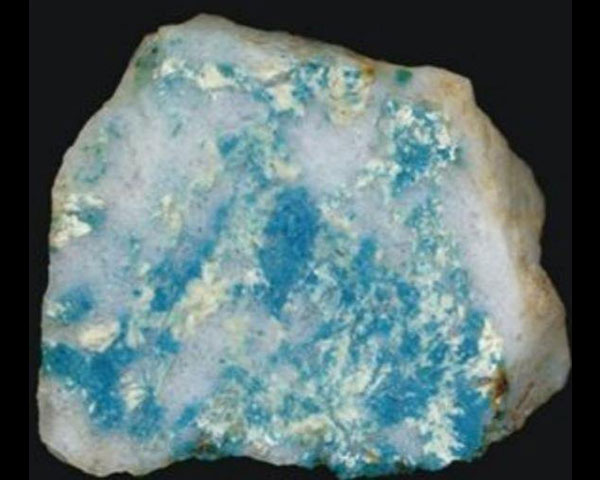The word Lazulite comes from the Latin word “Lazurius,” which evolved from the Arabic word “Azul,” meaning sky, heaven and blue.
Lazulite is an uncommon gem mineral, and massive Lazulite is obviously purple-blue. Some of them are like lapis lazuli, which belongs to middle and high-grade gemstones. Some people call them “fake lapis lazuli.”
The chemical formula of Lazulite is MgAl2 [PO4] 2 (OH) 2, and its composition often contains elements such as Fe, Mn, Ca, etc. It belongs to the monoclinic system; the crystals are cones, plate and granular, and the aggregates are massive.
- Mohs hardness: 5.5~6.
- Cleavage: {110} and {101} cleavage is incomplete.
- Density: 3.08-3.38g/cm.
- Optical property: inhomogeneous body, biaxial crystal, negative optical property.
- Refractive index: 1.612~1.663, birefringence: 0.031~0.037.
- Gloss: glass luster.
- Color: Blue with different tones.
- Multicolor: strong.
- Transparency: Translucent.
- Origin and occurrence: Lazulite occurs in high-grade aluminum metamorphic rocks rich in quartz, quartzite, and granite pegmatite.

Basic Properties of Lazulite
Chemical composition
The chemical formula of Lazulite is (Mg, Fe) Al2 [PO4] 2 (OH) 2, which is a base-containing aluminum magnesium phosphate mineral, in which some magnesium is often replaced by iron.
Morphology
Lazulite belongs to the monoclinic system, and the crystals are often in the shape of cones and columns. Plate-shaped crystals are rare, usually massive or granular aggregates.
Physical characteristics
Glass luster, transparent to almost opaque, common colors are dark green blue to purple-blue, blue-green, bluish-white, sky blue, blocky ones often have white spots. The biaxial crystal has negative optical properties, and the refractive index is Ng=1.642 ~ 1.673, Nm=1.633 ~ 1.646, and Np=1.604 ~ 1.620, which can increase with the increase of iron content. The double fold ratio is 0.031~0.036, 2V=64 °.
Strong pleochroism, α— Colorless, β— light blue, γ— Deep violet blue. It is erotic Under long-wave and short-wave ultraviolet light, and no characteristic absorption spectrum is found.
The cleavage is not clear, with uneven fracture or granular fracture. The Mohs hardness is 5-6, and the density is 3.09 (+0.08, -0.01) g/cm. Slightly soluble in hydrochloric acid.
Lazulite type
Scorzalite
Scorzalite is a hydroxy-containing aluminum iron phosphate mineral. The chemical formula is Fe2+Al2 (PO4) 2 (OH) 2, in which iron is often partially replaced by magnesium.
The physical property is similar to that of Lazulite, but the color is darker, and the refractive index and refractivity are larger: Ng=1.673~1.680, Nm=1.663~1.670, and Np=1.633~1.639; The birefringence rate is 0.040. Because of its dark color, it is less significant in gemology than Lazulite. It is often produced with Lazulite, but the quantity is small.
Spanishlazulite
It is a misnomer of cordierite produced in Spain with a color similar to sky blue.
bluespar
Common name of Lazulite .
Berkeyite
Another name for the Lazulite produced in Brazil.
How to identify Lazulite
When magnified, the massive aggregate may contain white inclusions.
Transparent Lazulite crystals are easily mixed with blue tourmaline and apatite, which have the same refractive index, birefringence and other optical properties. Still, we can determine them according to their polychrome.
Lazulite is somewhat similar to glaucophane and kyanite. The difference between Lazulite and glaucophane is that Lazulite has poor cleavage and high birefringence.
The difference between Lazulite and kyanite is that the refractive index of Lazulite is low and the birefringence is much higher.
Lazulite is somewhat similar to lapis lazuli, sometimes called “fake lapis lazuli.” The difference between Lazulite and lapis lazuli is that the refractivity of Lazulite is higher and the birefringence is much higher.
Where is Lazulite from?
Lazulite occurs in quartzite and metamorphic rocks, similar to quartzite and quartz and granite pegmatite in metamorphic rock areas.
It is usually associated with kyanite, andalusite, corundum, and garnet. It is mainly produced in India, Georgia, California, Austria, Sweden, Switzerland, Brazil, Angola, Madagascar, etc.
Conclusion:
Lazulite is a hydroxyl-containing aluminum magnesium phosphate mineral. The chemical formula is MgAl2 (PO4) 2 (OH) 2, in which magnesium is often partially replaced by ferrous. It belongs to the Monocline system; the crystal is sharp biconical, very rare, and usually in the form of massive aggregate.
Lazulite often occurs in quartz veins or pegmatite veins. The main producing areas are Bhandara in India, New Hampshire, and California in the United States, Minas Grice in Brazil, Angola, Sweden, Madagascar, Austria, etc.
It is a kind of high-grade gem that can be beautiful with lapis lazuli, so it is called “fake lapis lazuli.”
